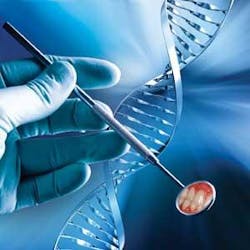DNA & Dentistry
I want to introduce you to a new friend of mine from Nashville, Tenn. Dr. Thomas Nabors is a general dentist who during his many years of practice had many questions about our treatment of periodontal disease. When we met, we were immediately drawn to one another because we were alike in so many ways. He is one of the most fascinating dentists that I have met in a long time. I found him to be an excellent teacher, so I wanted him to share some of his knowledge with you.
Dr. Blaes: Dr. Nabors, can you give some insight into what led you to this process?
Dr. Nabors: Today we have abundant evidence that periodontal diseases are much more specific than we once thought. The fact that each person is different and each infection is different is important to know. It is also important to realize that very specific microorganisms initiate this inflammatory process.
Thus, it becomes very important for us to know more than just the words plaque or biofilm. While many bacteria within the mouth can cause biofilms, it is the specific bacteria that we test for that have been shown to have the most pathogenic potential.
Another factor is the concern for systemic inflammation. Periodontal diseases are inflammatory diseases. And, not all bacteria within the mouth are equal when it comes to causing systemic inflammation. There are a number of species that are more pathogenic than others.
Recent agreements within the worlds of periodontology and cardiology have stated there are certain bacteria that we test for present increased risk for cardiovascular disease. This is big news and of paramount importance because we can now test for these high–risk pathogens.
Plus, when we diagnose disease with these bacteria present in high concentration, we need to know if our treatment has removed or reduced them to a host acceptable level. This decreases risk and the only way to have this information is through biological tests.
While our profession has made earlier attempts to detect bacteria, DNA–PCR techniques are a very important elevation in this scientific arena. This is new advanced technology that the world of medicine is using.
Plus, we now also know that genetics is a very important component to these infections. Today, we can identify a specific genetic marker that elevates risk when specific bacteria are present. This means that some of our patients are at even greater risk for more serious disease than people without this genetic trait (30% to 35% of our patients have this genetic variation).
In summary, periodontal diseases are inflammatory events that have specific causes and specific immune responses, and these specific bacteria can increase risk for tooth loss and systemic disease.
These infections are different in each person, and each person is responding to this bacterial assault based on his or her own unique genetic makeup and own personal circumstances.
Thus, the treatment of periodontal infections is not simply the removal of plaque, calculus, and biofilm. It must be first an excellent diagnosis of those bacteria that are present.
Then, whatever treatment we use, we need to know if our treatment has removed the cause of the infection. If not, the infection will return in a short period of time.
Dr. Blaes: I know that over the years the tests have changed and are now quite simple. Could you describe the tests and how we get them to OralDNA® Labs?
Dr. Nabors: The first test that we developed was to detect the specific microorganisms using sterile paper points. This test required that the point reach the apical one third of the pocket, required some degree of dexterity, more time, and the sample sites were selected based on visual observation.
We are very excited about our new test that uses a saline rinse. It requires only 30 seconds and will detect bacteria from all of the gingival spaces. This is due to the major advances in scientific knowledge as well as DNA–PCR technology. Saliva is proving to be the perfect choice for developing a series of diagnostic tests that gives a more complete view of the mouth, not just a few pockets.
Gingival crevicular flow (GCF) provides all of the information from even the deepest of pockets, thus paper points are no longer necessary. Plus, our new technology does not depend on the viability of microbes. There is evidence also that these bacteria occupy many different surfaces within the mouth.
The saline rinse has proven to be a very important improvement in both the sampling process and in the information that saliva provides.
All of our tests are available by calling (877) 577–9055 or by going to www.OralDNA.com. OralDNA® Labs is a division of Quest Diagnostics® Laboratories, which is on the Web at www.QuestDiagnostics.com.
Dr. Blaes: What is OralDNA® Labs testing for?
Dr. Nabors: Today, we offer three tests: Please let me describe.
MyPerioPath®
a. Detects (from bacterial DNA) the specific bacteria known to cause periodontal inflammation and destruction
b. Eleven species fall within this group
c. Sub–divides these bacteria into “risk” groups based on known risk/virulence properties: high, moderate, low
d. Determines concentration/bacterial load. (e.g., inflammatory burden).
e. Helps to determine therapy options based on bacterial risk assessment
MyPerioID® PST®
a. Detects (from human DNA) genetic variation/polymorphism within the IL–1 gene
b. IL–1 is a major inflammatory mediator
c. 30% to 35% of the U.S. population has this genetic variation
d. IL–1 positive individuals tend to have more aggressive and more severe infections
e. Determines patients that are most susceptible to severe disease, especially if the patients smoke
f. This genetic variation can increase risk for severe disease or tooth loss by 2 to 7 times when present
OraRisksm HPV
a. HPV (Human Papilloma Virus) is now a known risk factor for oropharyngeal carcinoma of the mouth and throat
b. HPV can cause cancer of the mouth and throat regions
c. Provides information to triage patient for high risk HPV without or with lesions
d. Detects those with HPV infections
e. Genotypes HPV based on known risk: high, low, unknown
f. Should be included in risk assessment for oral cancer in conjunction with clinical exam, adjunctive tests, and history of alcohol and tobacco.
Dr. Blaes: What types of patients should be considered for testing?
Dr. Nabors: MyPerioPath® should be used in the following scenarios:
- Patients presenting with signs and symptoms of a periodontal infection
- Patients with pockets of 4 mm or greater with clinical signs of a periodontal infection
MyPerioID® PST® should be used in the following scenarios:
- Patients with a family history of periodontal disease
- Patients with compromised immune systems
- Patients that have received therapy but continue with disease activity
- Patients that will receive implants and have lost teeth to periodontal disease
- Adolescent patients
OraRisksm HPV should be used in the following scenarios:
- Patients who are sexually active
- Patients with a family history of oral cancer
- Patients with signs and symptoms of oral cancer
- Patients with traditional risk factors for oral cancer
- Patients with suspicious oral lesions
Dr. Blaes: What kind of report will I receive from OralDNA® Labs?
Dr. Nabors: The clinical lab report for the bacterial test (MyPerioPath®) will include the following in full color:
- Specific bacterial profile of 11 species of bacteria known to initiate and sustain the inflammatory process
- The concentration/bacterial load of each bacteria
- A threshold line that indicates increased risk
- Ranking of the bacteria species based on virulence: high, moderate, low
- Specific names of the bacterial species and important information about each species
- Antimicrobials that might be helpful should the clinician decide they are needed: no longer will you have to “guess” at which antibiotic is best.
The clinical lab report for the periodontal genetic test (MyPerioID® PST®) will include the following in full color:
- Specific genetic markers that reflect increased susceptibility and increased risk for severe periodontal infections
- Reports are easy to interpret using “positive” or “negative” (yes/no) language
- Additional information regarding the significance, risk, and considerations related to the result
The clinical lab report for oral HPV (OraRisksm HPV) will include the following in full color:
- Specific HPV type and associated risk profile
- Significance, risk, and other considerations related to the findings.
Dr. Blaes: Can my dental team conduct the test, and how do they do it?
Dr. Nabors: Yes. The dental team can administer the test. Each test includes a 3 ml vial of sterile saline that the patient empties into his or her mouth. Depending on the test being performed, the patient will thoroughly swish or both swish and gargle with the saline solution.
The saliva/saline solution is then emptied into a collection funnel that flows into the collection tube. A bar code label is affixed to the collection tube along with the patient's name and date of birth. The sample is then packaged in a plastic bag and sent back to OralDNA® Labs via prepaid shipping labels from FedEx.
Dr. Blaes: How will DNA testing benefit the patient, the practice, and the profession?
Dr. Nabors: The tests from OralDNA® benefit the patient the same way that we all benefit from this medical model. The purpose of using any body fluid is to gather information from a biological prospective.
First, patients benefit by a diagnosis that is specific to their disease. The test determines the types of pathogens present plus the quantity of pathogens present. With this, the clinician can determine the exact course of treatment that is specific for the types and virulence of each infection.
Second, the ability to communicate to patients about their disease state based on the biological component is crucial information for them to know. Patients want to be healthy. This means they want to keep their teeth and they also want to know if their health is at risk.
Third, when this biological information is combined with the medical status and the dental history, a more specific treatment plan can be developed for each patient.
Fourth, patients tend to take more responsibility for their own disease state because they can see and understand the result report.
The dental practice benefits in some very specific ways as well:
- More patients are moved from traditional prophies into periodontal therapy based on these biological findings.
- The hygiene department becomes more of a periodontal treatment department.
- Differentiation: patients will see the difference and understand that your practice is unique.
- Regional practice: this type of differentiation can help your practice move from a “neighborhood” practice to a “regional” one.
- Communication: the lab report becomes the way we communicate with patients, with colleagues that may be co–managing our patients, and with physicians.
- Physicians: they want to know if their patients are infected or not when they refer them for clearance prior to a medical procedure. These reports are powerful ways to communicate.
- Liability: who is at greatest risk? The report becomes a permanent part of the patient's record.
- Risk assessment: medically compromised patients and patients with severe disease may best be served by co–management with your periodontist and the patient's physician. These reports help the doctor make that decision.
In conclusion, oral medicine is rapidly changing and we as clinicians are rapidly accepting diagnostic testing. The future looks bright for all of us and there are some exciting ways for all dental clinicians to contribute to saving teeth, as well as contributing in new ways to improve health in measurable ways.
Thank you Dr. Blaes for your interest in my work and for allowing me to give you a glimpse into this exciting new world of molecular diagnostics and how saliva will change the way we practice all forms of dentistry today and into the future.
Editor's Note: Dr. Nabors discussed the treatment of five cases using the protocol that he has described. These are posted on www.dentistryIQ.com.
Dr. Thomas W. Nabors practiced general dentistry for 38 years. He is a life member of the ADA, a member of many professional organizations, and a frequent lecturer. His knowledge and application of oral microbiology and genetics, as they pertain to oral medicine, makes him unique as a teacher. Upon his retirement from practice, he was instrumental in establishing OralDNA® Labs, Inc., where he now serves as chief dental officer. Dr. Nabors can be reached at [email protected].


